Injuries to the bark of the major commercial timber tree species are relatively frequent. They arise predominantly as skidding damage at the base of the trunk and also to a greater extent in particular in beech trees as felling damage in the higher sections of the trunk. As the extent of bark damage increases, the timber quality deteriorates, not only due to callus formation, but also due to discolouration and rot.
In order to investigate the effects of injuries to bark and how they are caused in harvesting timber, 40 trees of each of spruce, fir and beech were artificially injured, in order to simulate specific skidding and felling damage (only on beech). Two years after the wounds were inflicted, the wood properties in the area of the wound were examined with respect to discolouration, rot and other changes in the anatomical characteristics of wood. In addition, the fungus spectrum including the blue stain and wood-rotting fungi was quantitatively recorded.
Each species in its own way is capable of containing the discolouration and rot by activating physiological reactions to the injury. The forestry industry has already recognised advantages in fir and beech as compared with spruce with respect to the effects of skidding damage. On the other hand, rot had been reported in beech subsequent to felling damage.
Experiments on spruce and fir
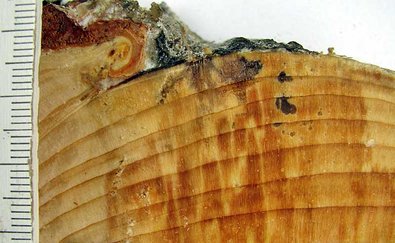
Fig. 1: Bark injuries in spruce lead to profuse resin flow and deep discolourations, which quickly develop into rotting.
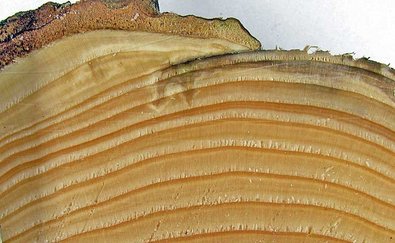
Fig. 2: In fir trees discolouration remains largely restricted to areas near the surface; rot is seldom seen.
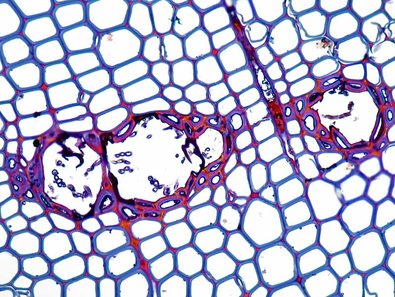
Fig. 3: The pre-formed resin ducts in the spruce quickly release resin; however, drying out encourages rapid axial colonisation of the tree body by fungi.
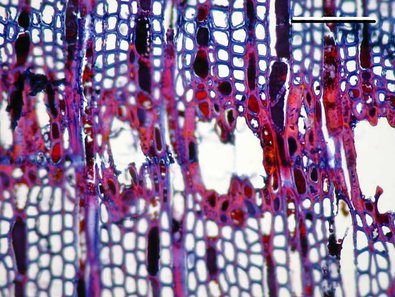
Fig. 4: Traumatic resin ducts also arise in fir trees in the new growth of wood around the edges of the injury (barrier zone). The additional storage of substances in the medullary rays prevent the wood from drying out (graduation mark = 100 µm).
Significantly greater drying out and a greater degree of fungal attack was noted in spruce in comparison to fir trees in the simulated skidding damage. The mean depth of penetration by rot was 2.3 cm on spruce and only 1.3 on fir trees. 20% of the spruce, but only 8% of the fir trees had already been attacked by rot, which had penetrated more than 4 cm into the wood (Fig. 1, 2). In three spruce trees (8%), but not in any single spruce tree, the discolouration had reached a linear expansion of more than 1 m.
During systematic isolation testing slightly less than five times more wood-destroying fungi were isolated from spruce than from fir trees. The most frequently isolated wood-destroying fungus was the bleeding stereum fungus (Stereum sanguinolentum), that is to say, ten times in spruce trees, but only once in fir. Only in spruce trees was this red-striped pathogen also isolated three times from DBH slices, indicating the axial spread of this fungus in the trunk. As microscopic investigations show, this rapid axial spread in spruce is also clearly favoured by the colonisation of the resin ducts (Fig. 3). Other frequent wood colonisers in spruce were Neonectria fuckeliana, Phomopsis spp., Leptodontium beauverioides, Ascocoryne cylichnium and the blue stain fungus, Ophiostoma piceae. Conversely, by storing phenolic compounds, the fir is obviously largely able to prevent the desiccation of the wood (Fig. 4).
Experiments on beech
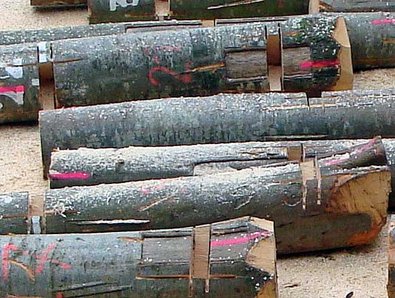
Fig. 5: Extraction of trunk slices from the centre of the bark aperture two years after injury to beech trunks.
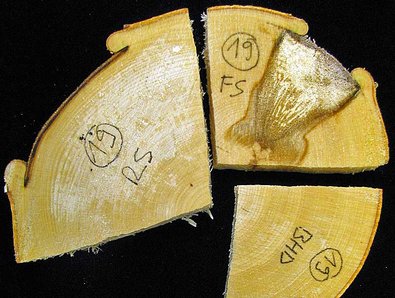
Fig. 6: Wood samples from a beech (tree 19) from the area of skidding damage (RS), felling damage (FS) and the DBH slice (BHD).
In the case of beech felling damage in the higher trunk areas clearly caused more massive damage in the wood, whereas the skidding damage at the base of the trunk resulted in this species in only minor discolourations. The investigation of trunk slices from the wound area (Fig. 5) showed a mean depth of penetration by discolourations or rot in the wound area of 3.2 cm in the case of felling damage whereas the depth of penetration for skidding damage was only 0.7 cm (Fig. 6).
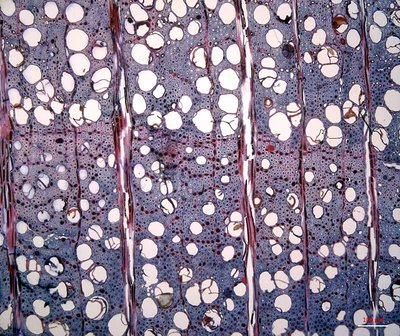
Fig. 7: The cross-section through the beechwood in the area of the skidding damage shows that the wound zone has been effectively sealed by phenolic substances in the medullary rays (seen here as lines running vertically), as well as in tangential series of parenchyma cells (dark chains of dots) and by extensive tylose of the vessels (rounded light brown structures). This impedes or prevents the wood from drying out at depth and impedes or prevents the penetration of fungi.
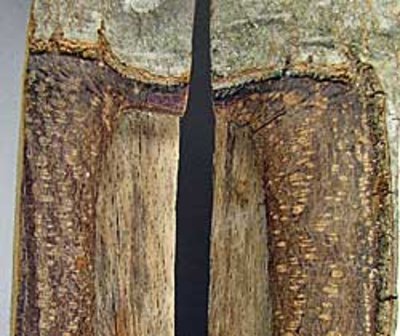
Fig. 8: The callousing of the wounds in the bark occurs principally from the lateral edges.
In the area of the skidding damage it was possible to ascertain superficial tylose of the vessels and the storage of phenolic substances in tangential series of parenchyma cells (Fig. 7), which impeded desiccation in each case. The reason for the more serious desiccation of the wound area in the upper trunk areas might be the less efficient water supply to that area. However, it cannot be excluded that the striped form of the "felling damage" also plays a role.
The most frequent fungal coloniser was the beech woodwart (Hypoxylon fragiforme), which is by a long way the most significant destroyer of wood. In addition, Phoma species occurred relatively frequently. Also, specifically on the surface of the wound, the leaf parasite Apiognomonia errabunda.
The callusing in the bark occurred principally from the lateral edges of the wounds. After two years at the end of the trial it had progressed on average 10 mm in the case of the felling damage and 15 mm for the skidding damage (Fig. 8).
Conclusions
Wounds in the bark at the base of the fir and beech trunks are sealed by physiological reactions specific to each species. This leads to less desiccation and thus also to only minor discolouration. This also inhibits the penetration of wood-destroying fungi and rot. However, in the case of beech, felling damage also results more frequently in intensive wood rot.
The spruce seals skidding damage less effectively, with the result that the sapwood beneath the wound in the bark dries out and dies. The areas of dead wood are therefore massively colonised by wood-destroying fungi. The resin ducts of the spruce seem to favour the axial colonisation of the wood.
Therefore, timber harvesting techniques must be used particularly carefully for spruce trees, in order to prevent bark damage and the associated devaluation of the timber. Also, in the case of beech, attention must be drawn to the avoidance of felling damage. Overall the experiment has provided information on the specific consequences of bark injuries, but not on the consequences of deeper mechanical damage to the tree body, which results in yet more drastic reduction in value.

